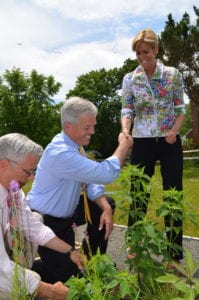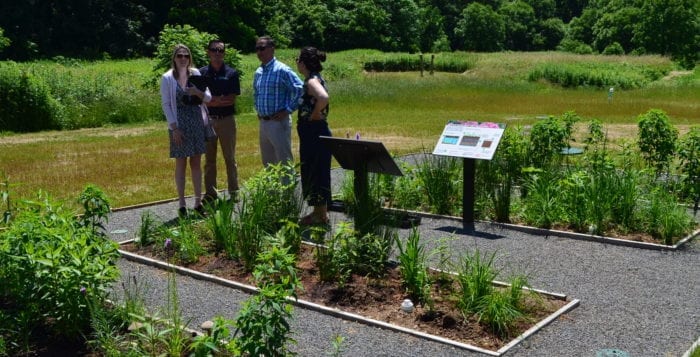By Donna Deedy
“It’s more than a pretty garden,” said Chris Clapp, a marine scientist for The Nature Conservancy. “It’s a biological process that relies on plants, wood chips and microbes to remove nitrogen in wastewater before it flows back into the environment.”
On June 24, County Executive Steve Bellone (D) joined Clapp with a conglomerate of representatives from both government and the private sector at The Nature Conservancy’s Upland Farms Sanctuary in Cold Spring Harbor to unveil a state-of-the-art method for reducing and eliminating nitrogen from wastewater.
The county expects the new system to be a replacement for cesspools and septic systems, which are blamed for the seeping of nitrogen into Long Island waterways, causing red tides, dead zones and closed beaches.

The issue is a serious concern, Bellone said, as he introduced the county’s Deputy Executive Peter Scully, who is spearheading the county’s Reclaim Our Water Initiative and serves as the Suffolk’s water czar. “Anytime a government appoints a water czar, you know you have problems to address.”
Scully, formerly the director for the Long Island region of the New York State Department of Environmental Conservation, said six other septic alternatives are currently approved.
Long Island is reportedly one of the most densely populated locations in the country without adequate wastewater treatment. Currently, there are 360,000 antiquated cesspools and septic systems. The county expects to set nitrogen reduction targets for watershed areas where replacement holds the most benefit.
The technique, called a vegetated circulating gravel system, is composed of an underground network that essentially connects the drains and toilets of a home or office to plant life and microbial action. It works in two stages to denitrify the wastewater. The first phase discharges wastewater into an underground gravel bed covered with a surprisingly small garden of native plants that takes up nitrogen through its roots. The water is then circulated into an underground box of wood chips that convert the remaining nitrogen into gas, before it’s circulated back to the gravel bed. Once the water is denitrified, it’s dispersed through a buried leaching field.
The county partnered with the Nature Conservancy to develop and implement the system for its Upland Farms Sanctuary. The sanctuary is located a half-mile from Cold Spring Harbor, where water quality has worsened during the last 12 years to the point where the state is officially proposing to designate it an impaired water body.
“The Conservancy is proud to stand alongside the county and our partners to celebrate this exciting new system that taps into the power of nature to combat the nitrogen crisis, putting us on a path to cleaner water,” said Nancy Kelley, Long Island chapter director for The Nature Conservancy.
During the experimental phase the system reduced by half the amount of nitrogen discharged from wastewater. A similar technique has been effective at removing up to 90% in other parts of the country. The system’s designers at Stony Brook University’s Center for Clean Water Technology aim to completely remove nitrogen from discharges. The Upland Farms offices and meeting hall system, which encompasses 156 square feet, serves the equivalent of two to three homes.
Suffolk County Legislator William “Doc” Spencer (D-Centerport) said that denitrification efforts work. The Centerport Yacht Club’s beach was closed for seven years due to water quality issues and reopened in 2015 after the Northport sewer plant upgraded to a denitrification system. Improvements to the harbor storm drain discharges, and a public lawn care campaign about curbing the use of fertilizers, also reportedly helped.
The county has reached a critical juncture and beginning July 1, its new sanitary code for septic systems takes effect, which permits only denitrifying technology.
Justin Jobin, who works on environmental projects with the Suffolk County Department of Health Services, said that he expects to gain approval for a pilot program to accelerate the vegetated circulating gravel system’s public introduction, which could be approved as soon as this summer. The design can be modified, its developers said, to serve single homes or large businesses. In addition to removing nitrogen, the system can also naturally filter out pharmaceuticals and personal care products. Its impacts on 1,4-dioxane are being studied.
Visit www.ReclaimOurWater.info for additional information.
Photos by Donna Deedy





